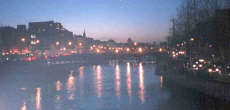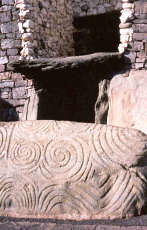
A view from the Ha’penny Bridge in central Dublin: “Back in the city after a day on the road.”
![]()
“Why is it called the Emerald Isle? Because it rains so much the grass is really green. Don’t forget to take an umbrella.”
So said the cynics when I told them I was planning a trip to Ireland. My boyfriend and I had decided that it would be an easy place to visit – just an hour from London on the plane, we were going to stay in Dublin, where they speak the same language, drive on the same side of the road, and know how to eat, drink and have a good time, despite the weather. But the country has an aura all its own. Leaving the faceless airport we were struck by the misty hills in the distance, statues of the Virgin Mary and the enticing Gaelic road signs – Drogheda, Black Bull, Ballyboghil… We decided to explore the countryside, not the city, so as soon as we were safely ensconced in our downtown hotel, we headed off towards Leopardstown.
An afternoon at the races did nothing to dispel the feeling that we were in a completely different world. Flocks of men in flat caps huddling round the bookmakers stalls, each with their own holdall full of money that opened mysteriously when a punter said the magic words… We won, then lost, and after the last windswept race we got in the car and drove the long way back to town.

Me outside Newgrange: “A blustery day in the Bru na Boinne” (valley of the Boine).
![]()
The countryside around Dublin has a split personality: there are countless new housing estates, either perfectly formed or half finished, as the blossoming economy means an increase in jobs and an influx of workers. But slightly off the beaten track is the older story: isolated farmhouses, quiet towns and tiny hamlets, where what we would consider the ‘real’ Ireland shows its character. Hoping to stop at a country pub in one charming village, we decided we didn’t want to disturb the atmosphere by going in – although visitors were welcome, we felt slightly uncomfortable: two out-of-towners trying their best to drink in some of the feeling of the place along with the Guinness.
After a cursory tour of the city’s premier sights, the next day the countryside called again – we set off without a map, without a guidebook, and just followed our noses and the most interesting roadsigns of the day before. Drogheda proved to be a tired-looking town with an industrial estate and a port, but Greystones was more promising. We arrived after dark and hit the coastal road. Turning a corner, there was the full moon over the wild sea; getting out of the car we stared down at the rocks being battered by the waves. We planned to return the next day, to see it in daylight, but the following morning we headed north, into the valley of the Boyne.
The area around the river Boyne is full of Neolithic archaeology, with even-shaped mounds clustered in groups or disturbing the skyline. The most famous and perhaps spectacular is the monument at Newgrange, a round hill with a white fa̤ade dominating the surrounding fields. Best seen on the winter solstice, when a beam of light creeps in across the floor to illuminate the altar, the carved inner walls of the tomb are impressive at any time of year. But it is only accessible via an organised tour Рmy boyfriend being an archaeology buff, we decided to look further afield.

Newgrange – the entry stone.
![]()
Heading off through the valley of the Boyne, it’s easy to find places to stop and admire the surrounding countryside. The site of the most famous Irish battle in history, the 1690 Battle of the Boyne, where William III defeated his Catholic opponent James II, there are markers all over of significant events in the battle which took place around the fordable river, as well as reminders of earlier settlers in the shape of more barrows and mounds. But perhaps more appealing are the rivers, glens and old buildings that can be found along the narrow country lanes. Following roads which wound back on themselves, we came across a ruined castle, quaint houses by the sea and a town with a spectacular bridge. And most importantly, enough fresh air to last us through another few months in grey polluted London.
After a blustery few days when the promised rain only made the briefest of appearances, we decided we had made the right decision when it came to Dublin. A couple of days enjoying the ‘craic’ are certainly fun – but can be enjoyed anywhere, albeit without the Dubliners’ flair and hospitality. But getting back to the ‘old’ Ireland – albeit not quite the one of people’s preconceptions – left me with a sense that I was glad to have experienced it, before it changes and disappears under another new housing estate.
We flew with Ryanair, which offers cheap deals including car hire from the UK.
Our hotel, the Leeson Inn, was booked online. Rates were very reasonable, around 55 euros a night for a double room with bathroom.
Questions?
If you want more information about this area you can email the author or check out our Europe Insiders page.